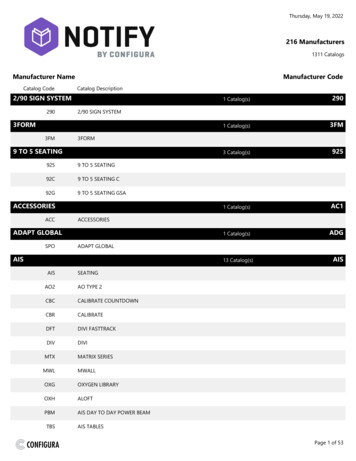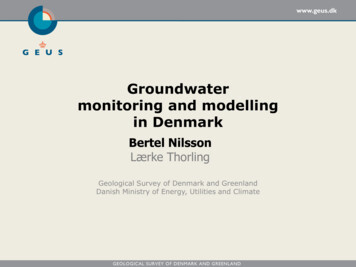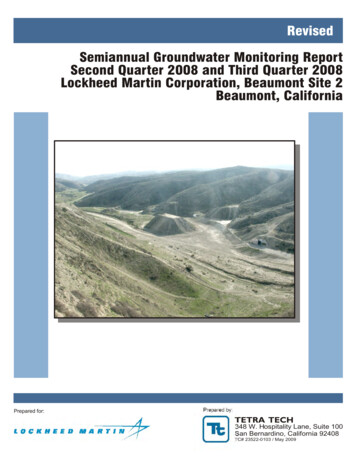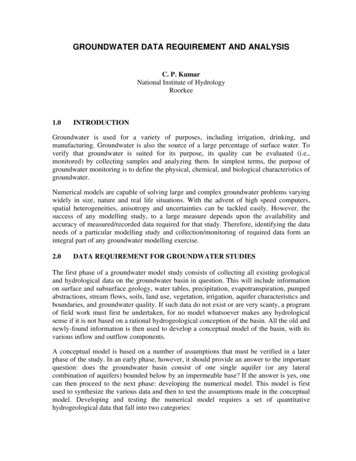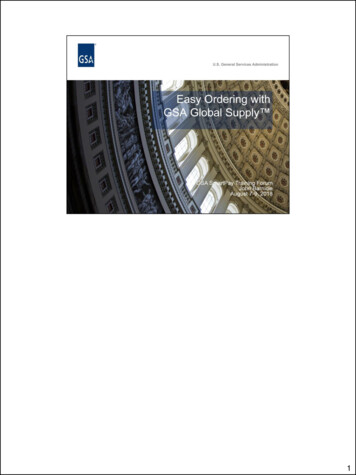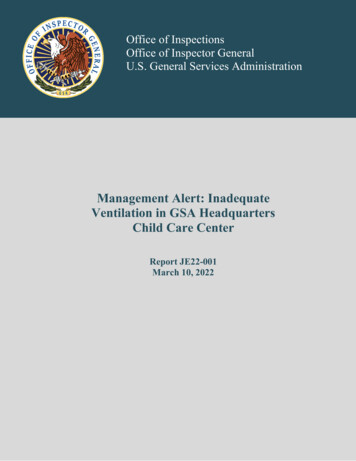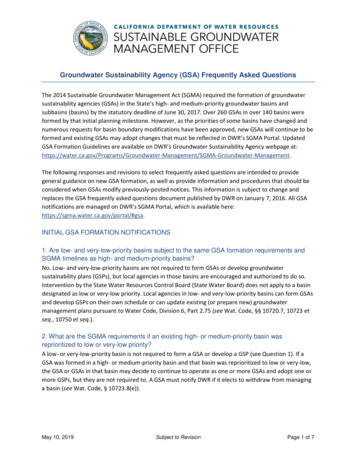
Transcription
Groundwater Sustainability Agency (GSA) Frequently Asked QuestionsThe 2014 Sustainable Groundwater Management Act (SGMA) required the formation of groundwatersustainability agencies (GSAs) in the State’s high- and medium-priority groundwater basins andsubbasins (basins) by the statutory deadline of June 30, 2017. Over 260 GSAs in over 140 basins wereformed by that initial planning milestone. However, as the priorities of some basins have changed andnumerous requests for basin boundary modifications have been approved, new GSAs will continue to beformed and existing GSAs may adopt changes that must be reflected in DWR’s SGMA Portal. UpdatedGSA Formation Guidelines are available on DWR’s Groundwater Sustainability Agency webpage ement/SGMA-Groundwater-Management.The following responses and revisions to select frequently asked questions are intended to providegeneral guidance on new GSA formation, as well as provide information and procedures that should beconsidered when GSAs modify previously-posted notices. This information is subject to change andreplaces the GSA frequently asked questions document published by DWR on January 7, 2016. All GSAnotifications are managed on DWR’s SGMA Portal, which is available here:https://sgma.water.ca.gov/portal/#gsa.INITIAL GSA FORMATION NOTIFICATIONS1. Are low- and very-low-priority basins subject to the same GSA formation requirements andSGMA timelines as high- and medium-priority basins?No. Low- and very-low-priority basins are not required to form GSAs or develop groundwatersustainability plans (GSPs), but local agencies in those basins are encouraged and authorized to do so.Intervention by the State Water Resources Control Board (State Water Board) does not apply to a basindesignated as low or very-low priority. Local agencies in low- and very-low-priority basins can form GSAsand develop GSPs on their own schedule or can update existing (or prepare new) groundwatermanagement plans pursuant to Water Code, Division 6, Part 2.75 (see Wat. Code, §§ 10720.7, 10723 etseq., 10750 et seq.).2. What are the SGMA requirements if an existing high- or medium-priority basin wasreprioritized to low or very-low priority?A low- or very-low-priority basin is not required to form a GSA or develop a GSP (see Question 1). If aGSA was formed in a high- or medium-priority basin and that basin was reprioritized to low or very-low,the GSA or GSAs in that basin may decide to continue to operate as one or more GSAs and adopt one ormore GSPs, but they are not required to. A GSA must notify DWR if it elects to withdraw from managinga basin (see Wat. Code, § 10723.8(e)).May 10, 2019Subject to RevisionPage 1 of 7
California Department of Water Resources – Sustainable Groundwater Management OfficeGSA Frequently Asked Questions3. Which local agencies are eligible to be GSAs?SGMA defines a “local agency” to mean a local public agency that has water supply, water management,or land use responsibilities within a groundwater basin (see Wat. Code, § 10721(n)). Any local agency orcombination of local agencies overlying a groundwater basin is eligible to become a GSA for that basin.The State Water Board addresses GSA eligibility questions on its Groundwater Management Programwebsite: https://www.waterboards.ca.gov/water issues/programs/gmp/eligibility.html4. What role do mutual water companies or water corporations play in GSA formation?A water corporation regulated by the Public Utilities Commission or a mutual water company mayparticipate in a GSA that has been formed by a local agency or a combination of local agencies, but onlya local agency may form a GSA. The authorities conferred upon a GSA by SGMA are not conferred to anongovernmental entity through participation in a GSA (see Wat. Code, §§ 10723, 10723.6).5. Upon deciding to become or form a GSA, what information must a local agency submit tohave a complete GSA formation notice?Within 30 days of deciding to become or form a GSA, the local agency or combination of local agenciesshall inform DWR of its decision and its intent to undertake sustainable groundwater management. Thenotification shall contain all the information required by Water Code section 10723.8(a). DWR willcompare maps and GIS shapefiles to determine if a proposed GSA has attempted to form outside of agroundwater basin, is proposing to become a GSA in an area that has already become exclusive toanother local agency, or has formed in areas that exceed a local agency’s ability to impose fees orregulatory requirements, which may be identified as unmanaged areas by the State Water Board. TheGSA formation notice will be reviewed for completeness by DWR staff and, if complete, will be postedon DWR’s SGMA Portal and GSA Map Viewer. (See Wat. Code, §§ 10721, 10723 et seq., and 10726.8.)6. When does the decision to become a GSA take effect?For local agencies not deemed exclusive by Water Code section 10723(c), the decision to become a GSAwill take effect 90 days after DWR posts the initial notice, provided that no other local agency has filed aGSA formation notice that overlaps all or a portion of the same area within that 90-day period. If overlapis resolved after the 90-day period, the decision to become a GSA will be effective immediately if allapplicable Water Code requirements have been met (see Wat. Code, § 10723.8). DWR tracks GSAformation overlap and identifies exclusive GSAs on the SGMA Portal. For agencies listed in Water Codesection 10723(c), the decision to become a GSA takes effect, within reported statutory boundaries, uponsubmission of a complete GSA notice to DWR. (See Wat. Code, §§ 10723(c), 10723(d), 10723.8, and10726.8(b).)7. Must the exclusive local agencies listed in Water Code section 10723 file a GSA formationnotice?Yes. SGMA identifies 18 exclusive local agencies created by statute to manage groundwater that are“deemed exclusive” within their respective statutory boundaries. The “deemed exclusive” statusprotects the statutory boundaries of the named local agency from encroachment by another localagency seeking to form a GSA. However, a “deemed exclusive” local agency must either notify DWR ofMay 10, 2019Subject to RevisionPage 2 of 7
California Department of Water Resources – Sustainable Groundwater Management OfficeGSA Frequently Asked Questionsits intent to form a GSA or of its decision to opt-out of being the exclusive GSA. If a “deemed exclusive”local agency submits a notice of intent to form a GSA, because there is no 90-day waiting period duringwhich another agency may file an overlapping notice, the “deemed exclusive” local agency shall beidentified as the exclusive GSA as soon as DWR posts that notice. On the other hand, if a “deemedexclusive” agency notifies DWR of its decision to opt out of being the exclusive groundwatermanagement agency, another local agency may file a notice for the area within the statutory boundariesof the “deemed exclusive” local agency (see Wat. Code, § 10723(c)).8. What is an exclusive GSA?An exclusive GSA is the sole GSA with jurisdiction over the area of a basin that the local agency ismanaging that is within the service area of the local agency (see Wat. Code, § 10723.8(d)). A localagency is presumed to be an exclusive GSA if no other local agency submits a GSA notice indicating anintent to manage some or all of the same area within 90 days of the first agency’s notification, or if anoverlap situation occurs within 90 days but has been resolved. Once a GSA becomes exclusive DWR willnot post another GSA formation notification that covers any portion of an exclusive area (see Wat. Code,§§ 10723(c), 10723(d), 10723.8, and 10726.8(b)). Note that local agencies that are “deemed exclusive”by Water Code section 10723(c) are not exclusive GSA’s until deciding to form a GSA and providingnotice of that decision to DWR.9. What is “overlap” and how is it created?If two or more local agencies submit a notice of intent to undertake groundwater management in all ora portion of the same area of a basin within 90 days of the initial posted notice, areas claimed bymultiple agencies creates “overlap” that must be resolved before the decision of any of the overlappingagencies to become a GSA can take effect (see Wat. Code, § 10723.8). Local agencies are stronglyencouraged to collaborate and coordinate their GSA formation efforts prior to submitting a notice toDWR. (Note that overlap does not apply within the statutory jurisdiction of local agencies “deemedexclusive” by Water Code section 10723(c), providing they do not “opt out” of forming a GSA.)10. How is overlap resolved?Overlap can be resolved by providing written notice to DWR of an intent to withdraw or modify a postedGSA formation notice to eliminate any overlap in the area proposed to be managed. A notice may bemodified if it does not involve a “material change” from the information in the posted notice. If a localagency determines that eliminating the overlap results in a “material change” to its GSA notice, theagency must withdraw the original notice and submit a new notification. A local agency can withdraw anotice using the “Withdraw” function in the SGMA Portal, which will move the GSA formation notice tothe “All Withdrawn GSAs” list. That agency will then have to submit a new notice for a new GSA. If alocal agency determines that modification to its GSA notice does not constitute a “material change”from the information in the posted notice, that agency can modify its posted notice by logging into theSGMA Portal and uploading necessary changes, which could involve revised maps, GIS shapefiles,resolutions or legal agreements. It is up to a local agency(s) to determine what constitutes a materialchange when modifying a posted notice. Additional information about modifying posted notices isincluded in the responses to Questions 20, 21 and 22. (See Wat. Code, § 10723 et seq.)May 10, 2019Subject to RevisionPage 3 of 7
California Department of Water Resources – Sustainable Groundwater Management OfficeGSA Frequently Asked Questions11. Can a local agency form a GSA for a portion of a basin located outside its boundaries?SGMA states that any local agency or combination of local agencies overlying a groundwater basin maydecide to become a GSA for that basin (see Wat. Code, § 10723(a)). However, a GSA will only be“exclusive” within the area of the basin within the service area of the local agency that the local agencyis managing as described in the initial GSA notice (see Wat. Code, § 10723(d)). Furthermore, nothing inthe Water Code authorizes a local agency to make a binding determination of the water rights of anyperson or entity, or to impose fees or regulatory requirements, on activities outside the boundaries ofthe local agency (see Wat. Code, § 10726.8(b)).Please see Question 2 on the State Water Board’s “Frequently Asked Questions on GroundwaterSustainability Agencies” document dated November 22, 2017, for a discussion of how the inclusion ofareas outside the boundaries of a local agency may be deemed unmanaged by the Board:https://www.waterboards.ca.gov/water issues/programs/gmp/docs/eligbility/gsa faq.pdf12. If overlap in a basin is not resolved will the county be the GSA in the disputed area?Overlaps occurs if two or more local agencies (including a county) submit a GSA formation notification inall or a portion of the same area in a basin within 90 days of the initial posted notice (see Question 9). Ifoverlap exists, the decision to become a GSA will not take effect unless the overlap is eliminated,potentially creating unmanaged areas in a basin if statutory deadlines have passed. SGMA provides thatif there is an area within a high- or medium-priority basin that is not within the management area of anestablished GSA, the county within which that unmanaged area lies will be presumed to be the GSA forthat area (see Wat. Code, § 10724(a)). DWR does not regard this provision to apply in situations where acounty is responsible for creating the overlap. In the unmanaged areas where the county is presumed tobe the GSA, the county must follow the same public notification procedures applicable to all localagencies seeking to become a GSA and submit that notice and other information required by SGMA toDWR (see Wat. Code, §§ 10723(b) and 10723.8(a)). However, a county is not required to become a GSAfor unmanaged areas and may notify DWR in writing that it will not be the GSA for those unmanagedareas.Please see Questions 3, 4, and 5 on the State Water Board’s “Frequently Asked Questions onGroundwater Sustainability Agencies” document dated November 22, 2017. These questions addressthe State Water Board’s opinion related to unmanaged areas and can be read here:https://www.waterboards.ca.gov/water issues/programs/gmp/docs/eligbility/gsa faq.pdf13. What happens if an entire basin is not covered by a GSA(s) by the statutory deadlines?If a high- or medium-priority basin is not entirely covered by one or more GSAs by the applicablestatutory deadline, and no Alternative has been submitted for that basin, the State Water Board, afternotice and a public hearing, may designate the basin as probationary (see Wat. Code, § 10735.2) andmay require the reporting of groundwater extractions (see Wat. Code, § 5202).May 10, 2019Subject to RevisionPage 4 of 7
California Department of Water Resources – Sustainable Groundwater Management OfficeGSA Frequently Asked QuestionsThe State Water Board has developed an interactive Unmanaged Area Identification Map that shows thelocation of unmanaged areas and has provided information related to State intervention on itsGroundwater Management Program website. Please review the information on the following website:https://www.waterboards.ca.gov/water issues/programs/gmp/14. Must a GSA be formed if a local agency wants to prepare and submit an Alternative Plan, asdescribed in Water Code section 10733.6?No, but a local agency, including the exclusive local agencies identified in Water Code section 10723(c),must be able to prepare an Alternative Plan for the entire basin and submit that Alternative Plan to DWRfor review by January 1, 2017, or within two years of being reprioritized as a high- or medium-prioritybasin. Conversely, if so desired, a GSA can be formed in a basin and that GSA can submit an AlternativePlan rather than a GSP. (See Wat. Code, §§ 10723(c), 10733.6.)15. Must a GSA be formed if portions of a basin are not adjudicated?A high- or medium-priority basin that includes adjudicated areas must be managed under a GSP orcoordinated GSPs, or an Alternative, even though the adjudicated areas already have reportingrequirements defined in SGMA (see Wat. Code, § 10720.8).16. Must a local agency exclude federal and tribal lands from its service area when forming aGSA?No local agency is required to include any particular area within the boundaries of a GSA that it forms;however, SGMA applies to all groundwater basins in California including, to the extent authorized underfederal or tribal law, Indian tribes and the federal government (see Wat. Code, § 10720.3), and requiresthat a GSP or combination of GSPs cover the “entire basin” (see Wat. Code, §§ 10727, 10733.4). If a GSAincludes federal or tribal lands within the boundaries of its GSA, SGMA provides that the federalgovernment or any federally recognized Indian tribe may voluntarily agree to participate in thepreparation or administration of a GSP, based on their independent authority.17. What are the stakeholder outreach responsibilities for local agencies and GSAs?Prior to initiating the development of a GSP, the GSA shall make available to the public and DWR awritten statement describing the manner in which interested parties may participate in thedevelopment and implementation of the GSP. In addition, a GSA is authorized to appoint and consultwith an advisory committee consisting of interested parties for the purposes of developing andimplementing a GSP. SGMA also requires a GSA to encourage the active involvement of diverse social,cultural, and economic elements of the population within the groundwater basin prior to and during thedevelopment and implementation of the GSP. (See Wat. Code, § 10727.8).Prior to deciding to become a GSA, a local agency must hold one or more noticed public hearings (seeWat. Code, § 10723(b)). SGMA also requires a GSA to consider the interests of all beneficial uses andusers of groundwater (see Wat. Code, § 10732.2) and to establish and maintain a list of interestedpersons (see Wat. Code, § 10723.4). SGMA authorizes a GSA to allow a water corporation or a mutualwater company to participate in the GSA (see Wat. Code, § 10723.6). SGMA does not specify how theMay 10, 2019Subject to RevisionPage 5 of 7
California Department of Water Resources – Sustainable Groundwater Management OfficeGSA Frequently Asked QuestionsGSA undertakes these responsibilities, but compliance with these requirements may provide anopportunity for public participation.18. When does a GSA get the powers and authorities defined in SGMA?As stated in Water Code section 10725, a GSA may exercise any of the powers described in Chapter 5 ofSGMA, in addition to, and not as a limitation on, any existing authority, if the GSA adopts and submits toDWR a GSP or an Alternative Plan.19. What are the GSA formation deadlines for basins that were re-prioritized in 2019?If the priority of a basin changes from low or very-low to medium or high after January 31, 2015, a localagency or combination of local agencies overlying a groundwater basin shall have two years from thedate of reprioritization to either establish a GSA or to submit an Alternative to DWR (see Wat. Code, §10722.4(d)(1)). A GSA shall have five years from the date of reprioritization to manage the basin under aGSP (see Wat. Code, §10722.4(d)(2)).MODIFIED GSA FORMATION NOTIFICATIONS20. Can GSAs in a basin change or restructure after June 30, 2017?SGMA does not preclude a GSA from making changes to its organizational structure. If a GSA modifiesany of the information that SGMA requires be provided to DWR, the GSA will need to submit copies ofthe amended information to DWR once the decision to restructure a GSA has been finalized. Allmodifications to a GSA’s posted notice must be made through the SGMA Portal. (See Wat. Code, §§10723 et seq., 10726.8, 10728, 10728.2, 10733 et seq. and 10735.2.)21. Once a GSA is formed how can it be modified?In order to modify a GSA formation notice posted on the SGMA Portal, an authorized user must log intothe GSA Formation System, make a determination that the modifications do or do not represent amaterial change, upload or replace necessary information, and resubmit that notification to DWR for acompleteness review. If a GSA wants to modify its boundaries or extend into an adjacent basin, it mayrequire a coordinated effort by multiple GSAs if exclusive GSA boundaries have been established. At thetime of this Frequently Asked Questions update, GSAs have inquired about making modifications relatedto the following scenarios. Each of these scenarios could warrant a GSA modification. A local agency has annexed additional land within a basin and wants to include that new landwithin its GSA. This will require coordination between the affected GSAs. The boundaries of a basin have changed and a GSA wants to update its GIS shapefiles to reflectmanagement intent. A GSP Initial Notification may need to be updated, too. A GSA with multiple notices in a single basin wants to consolidate its notifications. This willrequire notifications to be withdrawn and/or modified. Two or more existing GSAs want to replace their individual efforts with a joint powersagreement (JPA) – in this case the JPA will be the GSA. An existing GSA, which was formed using a JPA or some other legal agreement, wants to add orremove members and associated service area into or from its GSA boundary. This action couldrequire existing notifications to be modified and potentially new notices posted.May 10, 2019Subject to RevisionPage 6 of 7
California Department of Water Resources – Sustainable Groundwater Management OfficeGSA Frequently Asked Questions A local agency created a GSA in areas that exceeded its jurisdiction and wants to modify itsboundaries to reflect those areas it has the authority to regulate.A GSA formed by a memorandum of agreement (MOA) or other legal agreement wants tostrengthen its governance structure by replacing it with a JPA.The members of a GSA formed by a legal agreement want to disband that coordinatedgovernance structure and become individual GSAs. This action could require the posting of newnotices.The name of a basin has changed and a GSA needs to reflect that change in an existingresolution or legal agreement. Local agencies should follow their own legal guidelines andprocesses when making these decisions.22. Will modifications to an exclusive GSA notice create a new 90-day “waiting period” for therevisions to take effect?The 90-day waiting period is imposed by SGMA following DWR’s posting of the initial GSA noticesubmitted by a local agency, which gives other local agencies in the basin an opportunity to file GSAnotices that overlap the original notice. Because notices to modify an existing GSA are not initial notices,the 90-day waiting period does not automatically apply. However, if a GSA determines that thenecessary modifications involve a material change from the information in the posted notice, then theinitial GSA notice should be withdrawn and a new notice should be submitted, which would trigger anew 90-day period (see Wat. Code, § 10723.8(c)). See also the responses to Questions 6, 7, and 10.CONTACT USTo learn more about SGMA and GSA formation, please visit DWR’s Groundwater Management ter-Management.Additional questions related to GSAs and DWR’s role in posting complete GSA formation notices may bedirected to Mark Nordberg, GSA Project Manager, at (916) 651-9673 or Mark.Nordberg@water.ca.gov,or by contacting DWR’s Region Offices at sgmp rc@water.ca.gov.May 10, 2019Subject to RevisionPage 7 of 7
This information is subject to change and replaces the GSA frequently asked questions document published by DWR on January 7, 2016. . management plans pursuant to Water Code, Division 6, Part 2.75 (see Wat. Code, §§ 10720.7, 10723 et seq . A low- or very-low-priority basin is not required to form a GSA or develop a GSP (see Question 1). If a
